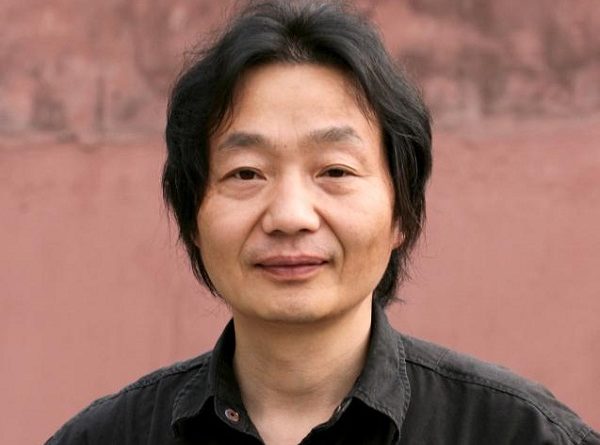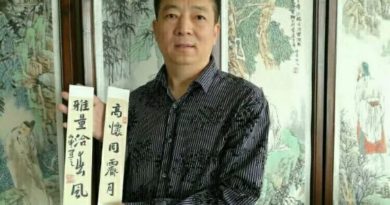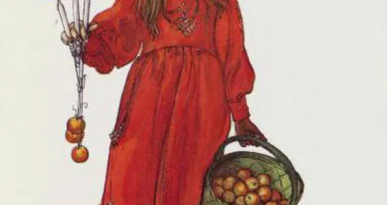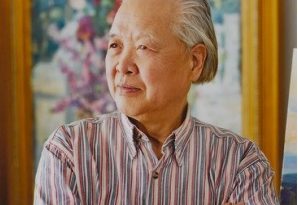追痕 ——倪卫华的绘画创作

倪卫华先生是一位具有实验精神和社会批判意识的当代艺术家,他自九十年代初创作《连续扩散事态——红盒、招贴》《线性城市》等大型系列行为作品起,就引起了艺术界和文化界的高度关注。他的早期作品通过与社会生活语境构成嵌入式的“互文性”,对现代工业化社会进行了一种机智的诘难与反讽。成为九十年代最具代表性的艺术家之一。
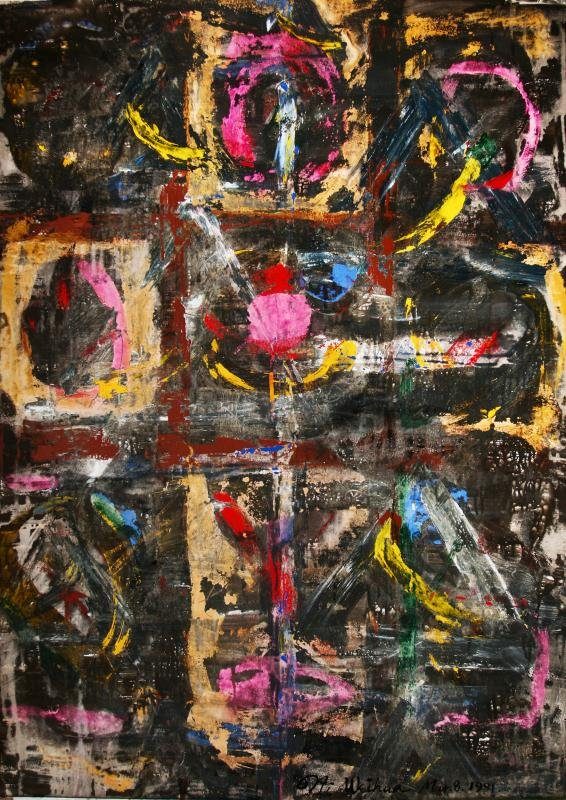
漂浮的文明踪迹之十 1991 109x79cm
1998年至今,他又通过影像(摄影与摄像)创作,以独特的视角聚焦公共领域关键词“发展与和谐”和公共空间“风景墙”,从而成功地实现了他“跨文化、跨意识形态”艺术实验的创作转型。

追痕 – 人体 (十一) 2018 79x79cm
倪卫华的绘画《追痕》系列作品则是他“遗迹”绘画实验的再延伸,他试图通过边缘描摹追溯手法,更加突显“人为”与“偶发”痕迹的交融集合,并将抽象表现主义的痕迹进行“波普化”处理,从而思考一种介于狂野与宁静、感性与理性、自然与人性、瞬间与永恒之间的意味。

追痕 – 环形体 (一) 1991/2017 79x79cm
艺术家裴满意先生是这样评论倪卫华的艺术作品“追痕”的。

追痕 – 框架 1 2018 158x158cm
倪卫华作为“老牌新锐”艺术家,最近创作的“追痕”系列,颇引人深思。他的可贵之处在于他的敏锐性,是从现实的问题出发,而不是单纯的借用空洞的“哲学理论”。自1989年“新表现”绘画个展以来,尽管他主要从事装置、影像等形态的艺术创作并在国内外获得了斐然的成就,但他依然没有放弃绘画,我在他的工作室几乎看完了其各个阶段的作品。给我的感觉是,他对于每一阶段,他都有着严肃的思考路径与批判方式,是观念逻辑下的递进、颤变与融超。
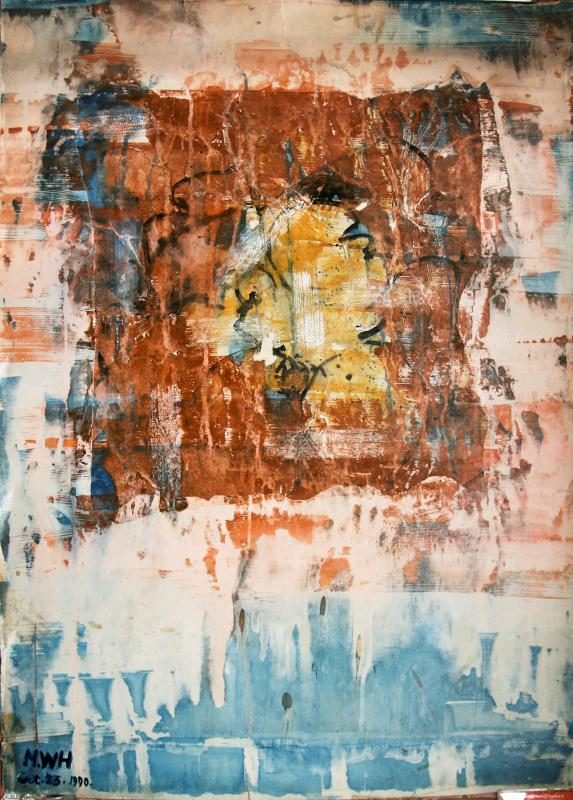
漂浮的文明踪迹之三 1990 109x79cm
此外,他不仅仅就绘画而言绘画,而是把它在装置、观念摄影等前卫艺术上的“独特”思考,融进绘画,从而探索出一条个体化的突破“元绘画”的实践与经验路径。这种跨界所得到的感悟是与传统的单一的职业画家不一样的。正如其言:“我的绘画作品在艺术观念上突出对人类学的关注,强调‘当代形象即历史图像’的理念。作品以纸本为基材,运用水彩、丙烯、水墨等综合材 料,通过堆砌、覆盖、冲刷、渲染、泼洒等综合手法,将具有当代特征的人象、 物象和活动轨迹植入到岩画般的‘遗迹’中,仿佛千万年以后的人们拂开尘埃和污垢后看到的一个场景——通过‘视觉考古学’,从另一个维度发掘当代人的特征、活动轨迹与审美文化信息。”

追痕 – 户外 (周家牌路 1 ) 2018 约 4.5x3m
通过户外绘画,倪卫华在不同艺术门类的“穿梭”,形成了他独特的“超-个体化”文化自觉。特别是他对摄影、图像的思考方式,似乎让我们再次发现户外绘画的另一种叙事方式。对此,我称之为是一种强调社会介入后的再“个体化”绘画自觉。

追痕 – 魔盒 (一) 2018 79x79cm
在梳理倪卫华观念逻辑构建的学理过程中,可以明显地感觉到他将福柯的“知识考古”理论,通过自身的实践延异至“视觉考古”这一更大的视觉文化范畴。这与其几位理论界的好友的研究方向是不谋而合的。例如美国芝加哥美术学院美术史论与批评系主任詹姆斯·埃尔金斯(James Elkins)教授。他是研究图像与视觉艺术的著名学者,其《图像的领域》等著作,对图像的研究范围及方式做了革命式的推动,他将视域扩展到非艺术的图像,包括科学、技术、商业、医学、音乐和考古等,从而把视觉研究跨向了非艺术领域;另一位则是复旦大学哲学学院沈语冰教授,其在最新的著作《图像与意义》当中,着重研究了乔纳森·克拉里的视觉考古学[9],此外还有王南溟等批评家。倪卫华与他们一同或在理论上,或在艺术实践上,都有着类似的默契。
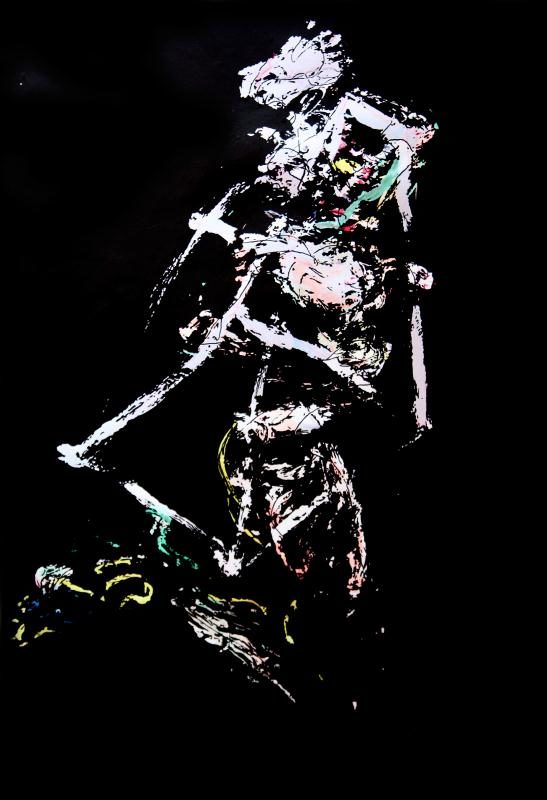
追痕-人体(三)2017 79x54cm
倪卫华是一个敏锐的时代观察者,他在自己近30年的当代艺术创作历程中,始终保持着“批判”的锐利,这是难能可贵的。他在自己的艺术上观念的逻辑构建路径与方法,似乎也给当代艺术的创作提供了一种思考的媒介。”
Ni Weihua,one of the contemporary artists,has the experimental spirit and social criticism. Since the beginning of 1990s, his large-scale action works named Continuously Spreading Event -Red Boxes ,Posters,Linear Cities,etc. has arisen the high focus from the artistic and cultural circles.The intertextuality with social life context of his early works,makes one kind of the heckle and irony to the modern industrialized society tactfully. He becomes one of the most representative artists in 1990s.
Since now from 1998,with the creation of image(photograph and video),focusing on the key words of the development and harmoniousness in public view and the landscape wall in public space through a particular angle,he realizes his creation reformation on art experiment of cross-culture and cross-ideology successfully.
Ni Weihua’s another series, Tracing, is an extension of his previous experiment in “paintings of remains.” Upon sketching and emphasizing the contours, he wants to highlight the merging of “intentional” and “incidental” clues, and to depict the abstract-expressionist traces through Pop-Art techniques. The essence lies between chaos and serenity, sense and sensibility, nature and humanity, as well as transience and eternity.
Mr Pei Man Yi made the following comment on Mr Ni’s paintings “Tracing Series”.
“Tracing Series, recently created by Ni Weihua, a “veteran emerging astist”, is quite thought-provoking.
He’s merits lie in his keenness which starts from real problems, rather than simply borrowing empty philosophical theories. Since the solo painting exhibition of the New Representation in 1989, although he later mainly engaged in installation and photography and other artistic creation, and made great achievements in the domestic and foreign art circles, but he has not given up painting. I have almost finished appreciating his works in various stages in his studio. My feeling is that he has a solemn path of thinking and criticism for each stage, which is progressive, changing, transforming and elevating from the perspective of conceptual logic. As he said in the Tracing Series, “This series is a re-extension of my painting experiment dubbed ‘remaining traces’. I try to highlight the interaction between artificial and occasional traces through edge depicting, and popularize the traces of abstract expressionism. In this way, a space is created to ponder between wildness and tranquility, sensibility and rationality, nature and humanity, and instant and eternity.
In addition, he not only paints for painting’s end, but also integrates his unique thinking in avant-garde art such as installation and conceptual photography into painting, thus exploring an individualized path bursting out of the practices and experience of metapicture. This kind of cross-school perception is different from that of the professional painters in a traditional sense. As he has said, “My paintings focus on anthropology from the perspective of artistic concepts and emphasize the concept that contemporary images are historical pictures. The works use the paper as the basic material, and implant human figures, objects and activity trajectories with contemporary features onto the traces resembling cliff painting, with watercolor, acrylic, ink and other comprehensive materials, and through stacking, covering, scouring, coloring, splashing and other comprehensive techniques. The images created are as if the first that people see after blowing thousands of years of dust and dirt. Through visual archaeology, I try to explore the characteristics, activity trajectories and aesthetic and cultural information of the contemporary people from another dimension.”
Outdoor painting is very common in the art history and there is nothing unusual. However, the author believes that his shuttling in different art categories has helped to form his unique “super-individualized” cultural consciousness. In particular, his thinking pattern of photography and images seems to make us discover another narrative way of outdoor painting. In this regard, I call it a re-individualized painting consciousness formed after emphasizing social intervention.
In summarizing the process of the logical construction of concepts by Ni Weihua, it can be clearly felt that he has extended Foucault’s knowledge archaeology theory to a larger visual and cultural category of visual archaeology through his own practice. This coincides with the research direction of his several friends in the theoretical circle. For example, Professor James Elkins, E.C. Chadbourne Chair of art history, theory, and criticism at the School of the Art Institute of Chicago, USA. He is a well-known scholar who studies images and visual art. His The Domain of Images and other works have revolutionized the scope and methods of image research. He extends the field of vision to non-artistic images, including science, technology, business, medicine, music, archaeology, etc., thus shifting visual research to non-art fields. Professor Shen Yubing of Fudan University’s School of Philosophy is another example in case. In his latest work Images and Meanings, he focuses on visual archaeology of Jonathan Crary.. Ni Weihua is tacitly connected with them, either in theory or in art practice.
Ni Weihua is a keen observer of the times. In his 30 years of contemporary art creation, he has always maintained a sharpness of criticism, which is commendable. His logical construction path and approach of his artistic concepts also seem to provide a medium of thinking for the creation of contemporary art.
《国际艺术新闻网》记者 徐晶

